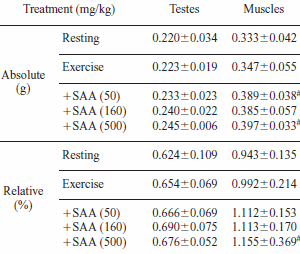Silk Amino Acids, what is all the hype about ?
Posted: Friday, 9 March 2012 by Strength&Nutrition24/7 in Labels: Supplement
0
The
researchers, working for Chungbuk National University and Worldway manufacturer, gave male
mice a daily preparation containing hydrolyzed silk proteins. The preparation,
produced by Worldway[www.worldway.co.kr],
consisted of 34 percent alanine, 27 percent glycine, 10 percent serine, 3
percent valine and 2 percent threonine. Most hydrolyzed silk peptides consist
of a chain of 18-19 amino acids, so this is probably true of the preparation
that the researchers tested. The mice were given doses of 50, 160 or 500 mg/kg
silk proteins dissolved in water.
Half an hour after administration, the animals were made to swim for 30 minutes. A control group was given only water, but also made to swim.
On days 14, 18, 28
and 42 a weight was attached to the mice’s tail and they had to swim to the
point of exhaustion. The mice that had been given Silk Amino Acids held out for
considerably longer than the mice in the control group.
After 44 days the Koreans measured the
concentrations of cortisone [the inactive analogue of cortisol] and
testosterone in the mice’s blood, after a 30-minute swimming session. The
swimming reduced the testosterone in the control group mice, but in the
mice that had had Silk Amino Acids it had risen. The effect was particularly
noticeable at low doses.
After
44 days the Koreans measured the concentrations of cortisone [the inactive
analogue of cortisol] and testosterone in the mice’s blood, after a 30-minute
swimming session. The swimming reduced the testosterone level in the control
group mice, but in the mice that had had Silk Amino Acids it had risen. The
effect was particularly noticeable at low doses.
When the Koreans
examined the body composition of the mice after 44 days, they noticed that the
Silk Amino Acids had increased the muscle mass.
As far as we can
tell from the study, the mechanism behind the performance-enhancing effect is
two-pronged. To start with, Silk
Amino Acids protect the muscles against damage from radicals that arise from
physical exertion. The researchers measured the amount of thiobarbituric acid
reactive substances [TBARS] in the calf muscle. TBARS arise when radicals
attack the fatty acids in membranes. The table below shows mg TBARS/gram tissue
after 44 days.
Another mechanism is
that the Silk Amino Acids boost the production of glycogen in the liver and the
muscles.
The researchers used
daily doses of 50, 160 and 500 mg/kg. For an athlete weighing 85 kg that
amounts to 4.3, 13.6 or 42.5 g Silk Amino Acids per day. Fortunately rodents’
metabolism is about ten times higher than that of humans, so you can
comfortably divide the dosages by 10.







.jpg)





